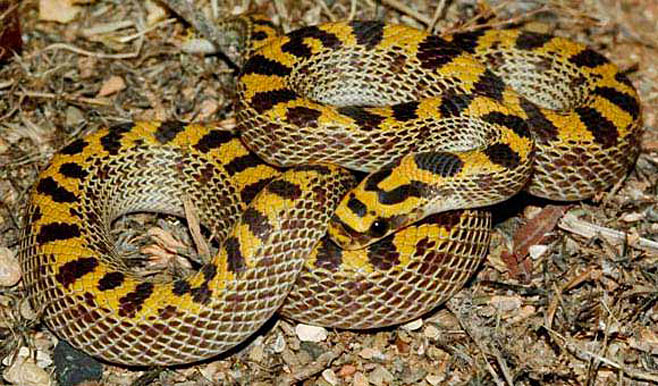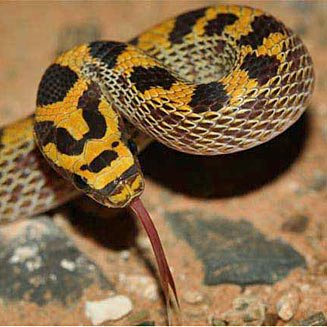|
Lamprophis fiskii (Fisk's house snake)
Fisk se huisslang [Afrikaans]
Life >
Eukaryotes
>
Opisthokonta >
Metazoa
(animals) > Bilateria > Deuterostomia >
Chordata >
Craniata > Vertebrata (vertebrates) > Gnathostomata (jawed vertebrates) >
Teleostomi (teleost fish) > Osteichthyes (bony fish) > Class:
Sarcopterygii (lobe-finned fish) > Stegocephalia (terrestrial vertebrates) >
Tetrapoda
(four-legged vertebrates) > Reptiliomorpha > Amniota >
Reptilia (reptiles) >
Romeriida > Diapsida > Lepidosauromorpha > Lepidosauria >
Squamata > Serpentes
(snakes) > Family: Colubridae > Subfamily:
Boodontinae > Genus:
Lamprophis
 |
 |
|
|
Lamprophis fiskii (Fisk's house snake), Western Cape [C. Dorse and
S. Van Rooyen © from
SARCA Virtual Museum] |
Identification
The Fisk's house snake can be identified by its lemon
yellow colouration, dark brown spots and its strictly nocturnal lifestyle. It
grows to an average length of 35 cm but may reach 40 cm.
Distribution and habitat
The distribution of this snake is restricted to 4 small
patches in the Western Cape and Northern Cape. Its preferred habitat is karoo
scrub.
Food
Feeds on geckos and lizards.
Predators, parasites and disease
Eaten by other snakes.
Reproduction
Oviparous (egg-laying), one specimen is known to have laid
8 eggs.
Longevity
Has been known to live for 20 years in
captivity.
Medical importance
Non-venomous and not dangerous to man and not likely to
bite.
Links
References
-
Broadley, D.G. 1983. FitzSimons' Snakes of Southern
Africa. Delta Books, Johannesburg.
-
Marais, J. 2004. A Complete Guide to Snakes of
Southern Africa. Struik Publishing, Cape Town.
|
